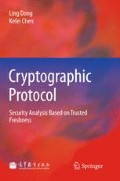Abstract
Informal design principle research and formal design method research are the two main parts of cryptographic protocol design research. We have presented ten cryptographic protocol engineering principles for protocol design in Chapter 4, and a belief multiset design model based on trusted freshness is put forward in this chapter. Moreover, the efficiency of the key establishment protocol is also discussed.
Access this chapter
Tax calculation will be finalised at checkout
Purchases are for personal use only
Preview
Unable to display preview. Download preview PDF.
References
Burrows M, Abadi M, Needham R (1990) A Logic of Authentication. ACM Transactions on Computer Systems 8(1): 18–36
Bellare M, Canetti R, Krawczyk H (1998) A Modular Approach to the Design and Analysis of Authentication and Key-exchange Protocols. In: Proceedings of the 30th STOC, Dallas, 23–26 May 1998
Heintze N, Tygar J (1996) A Model for Secure Protocols and Their Compositions. IEEE Transactions on Software Engineering 22(1): 16–30
Bellare M, Rogaway P (1993) Entity Authentication and Key Distribution. In: CRYPTO’93 Proceedings of the 13th Annual International Cryptology Conference on Advances in Cryptology, Santa Barbara, 22–26 Aug 1993. Lecture Notes in Computer Science, vol 773, pp 232–249, Springer
Canetti R, Krawczy H (2001) Analysis of Key-exchange Protocols and Their Use for Building Secure Channels. In: EUROCRYPT’01 Proceedings of the International Conference on the Theory and Application of Cryptographic Techniques: Advances in Cryptology, Innsbruck, 6–10 May 2001. Lecture Notes in Computer Science, vol 2045, pp 453–474, Springer
Goldwasser S, Micali S (1984) Probabilistic Encryption. Journal of Computer and System Sciences 28(2): 270–299
Datta A, Derek A, Mitchell JC, Warinschi B (2006) Computationally Sound Composi-tional Logic for Key Exchange Protocols. In: Proceedings of the 19th IEEE Computer Security Foundations Workshop, Venice, 5–7 July 2006
Canetti R, Rabin T (2003) Universal Composition with Joint State. In: CRYPTO’03 Proceedings of the 23rd Annual International Cryptology Conference on Advances in Cryptology, Santa Barbara, 17–21 Aug 2003. Lecture Notes in Computer Science, vol 2729, pp 265–281, Springer
Dong L (2008) Cryptographic Protocol Engineering and Protocol Security Based on Trusted Freshness. PhD Dissertation (in Chinese), Shanghai Jiaotong University
Dong L, Chen K, Lai X (2009) Belief Multisets for Cryptographic Protocol Analysis. Journal of Software 20(11): 3060–3076 (in Chinese)
Buttyan L, Staamann S, Wilhelm U (1998) A Simple Logic for Authentication Protocol Design. In: Proceedings of the 11th IEEE Computer Security Foundations Workshop, Rockport, 9–11 June 1998
Gong L, Syverson P (1995) Fail-stop Protocols: An Approach to Designing Secure Protocols. In: Proceedings of IFIP DCCA-5, Illinois, 27–29 Sept 1995
Lamport L (1978) Time, Clocks and the Ordering of Events in a Distributed System. Communication of the ACM 21(7): 558–565
Datta A, Derek A, Mitchell JC, Pavlovic D (2003) A Derivation System for Security Protocols and its Logical Foundation. In: Proceedings of the 16th IEEE Computer Security Foundations Workshop, Pacific Grove, 30 June–2 July 2003
Gong L (1995) Optimal Authentication Protocols Resistant to Password Guessing Attacks. In: CSDW’95 Proceedings of the 8th IEEE Workshop on Computer Security Foundations, County Kerry, Ireland, 13–15 June 1995
Guttman JD, Thayer F (2000) Authentication Tests. In: Proceedings of the IEEE Symposium on Security and Privacy, Berkeley, 14–17 May 2000
Datta A, Derek A, Mitchell JC, Roy A (2007) Protocol Composition Logic (PCL). Electronic Notes in Theoretical Computer Science 172: 311–358.
Menezes A, van Oorschot P, Vanstone S (1996) Handbook of Applied Cryptography. CRC Press, New York
Mao W (2004) Modern Cryptography: Theory and Practice. Prentice Hall, New Jersey
Gong L, Needham R, Yahalom R (1990) Reasoning About Belief in Cryptographic Protocols. In Proceedings of the 1990 IEEE Symposium on Research in Security and Privacy, Oakland, 7–9 May 1990
Syverson PF, Oorschot PCV (1994) On Unifying Some Cryptographic Protocol Logics. In: Proceedings of the 1994 IEEE Symposium on Research in Security and Privacy, Oakland, 16–18 May 1994
Gong L (1993) Lower Bounds on Messages and Rounds for Network Authentication Protocols. In: CCS’93 Proceedings of the 1st ACM Conference on Computer and Communications Security, Fairfax, 3–5 Nov 1993
Gong L (1994) Efficient Network Authentication Protocols: Lower Bounds and Optimal Implementations. Technical Report SRI-CSL-94-15, Computer Science LaboratorySRI International, 1994
Author information
Authors and Affiliations
Rights and permissions
Copyright information
© 2012 Higher Education Press, Beijing and Springer-Verlag Berlin Heidelberg
About this chapter
Cite this chapter
Dong, L., Chen, K. (2012). Design of Cryptographic Protocols Based on Trusted Freshness. In: Cryptographic Protocol. Springer, Berlin, Heidelberg. https://doi.org/10.1007/978-3-642-24073-7_8
Download citation
DOI: https://doi.org/10.1007/978-3-642-24073-7_8
Publisher Name: Springer, Berlin, Heidelberg
Print ISBN: 978-3-642-24072-0
Online ISBN: 978-3-642-24073-7
eBook Packages: Computer ScienceComputer Science (R0)

